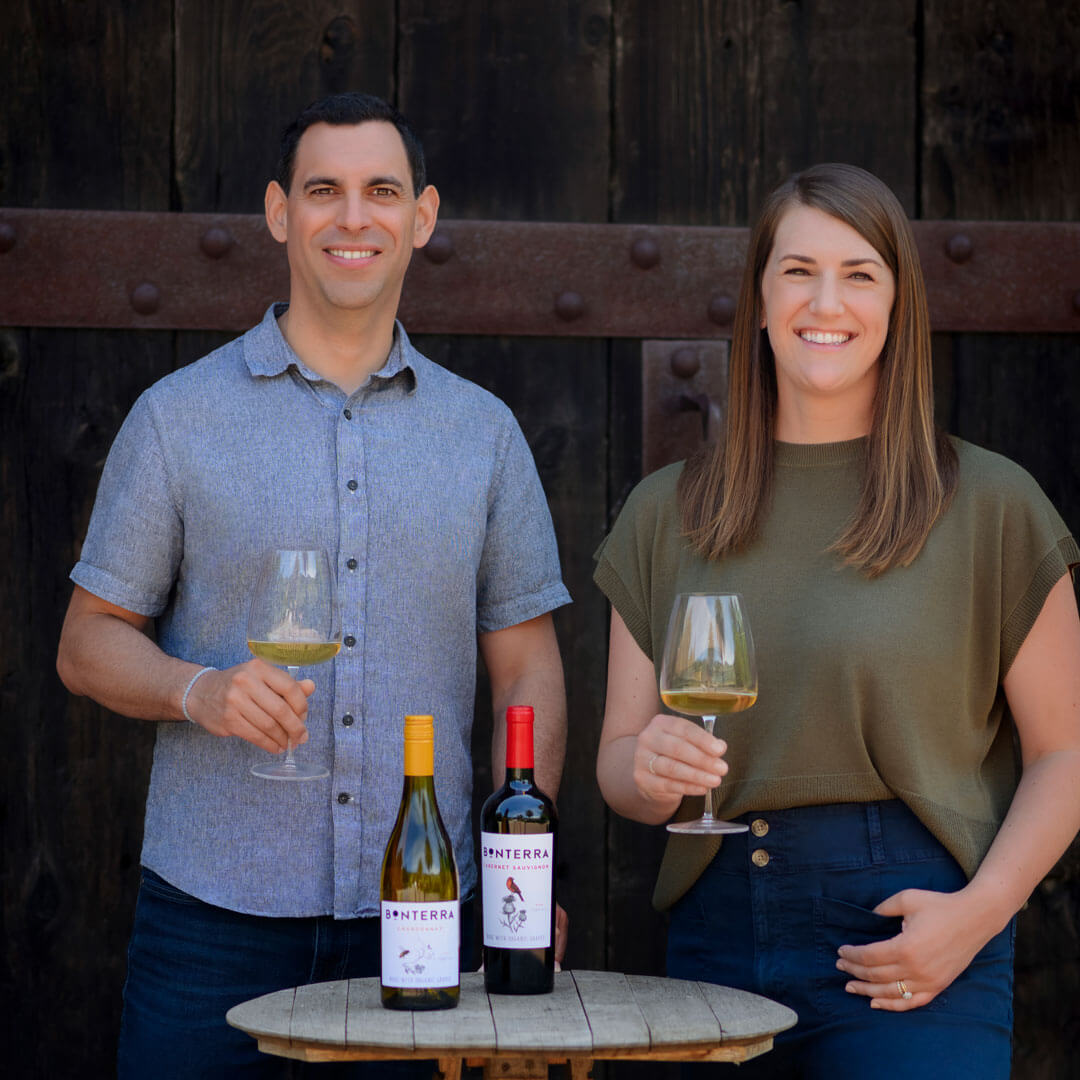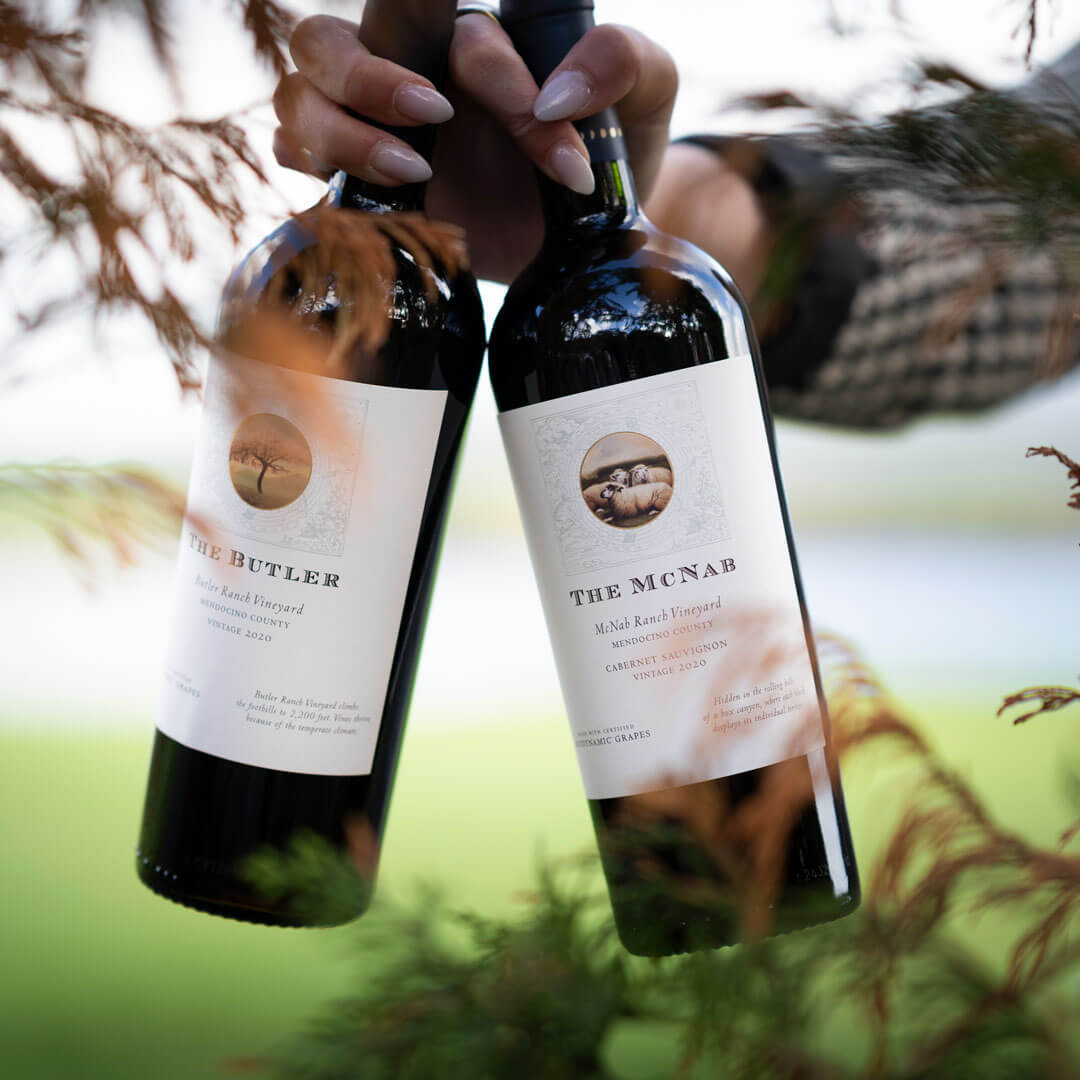We know it’s a little strange to talk about a beverage having a “body.” It’s a liquid, after all! But the world of wine is a poetic one, and “body” is the traditional metaphor for talking about a wine’s weight and mouthfeel. A wine’s body has an important impact on our wine tasting experience, especially when it comes to food pairings. As a result, understanding wine body helps us make better informed decisions about our preferences in wine style and enhances our overall wine tasting experience.
Bonterra’s online wine collection includes light, medium, and full-bodied options from our organic winery, offering something for every taste and occasion. We hope you’ll use them as benchmarks as you explore different styles of wine body at home!
What Is Wine Body?
The body of a wine is the texture or weight of the wine on the palate, typically described as light, medium, or full. We like to compare light-bodied wines to the texture of skim milk – very light, translucent and delicate. Medium-bodied wines feel more like 2% or full-fat milk, with a thicker texture and more richness. Full-bodied wines are more like half and half, where each sip coats your palate and feels rich and weighty.
Many factors influence the type of body a wine has, including alcohol content, sugar levels, tannins in wine, and the wine’s overall composition. Let’s dig into each of these a bit.
Factors That Influence Wine Body
Alcohol Content
Alcohol molecules have a weightier texture than water molecules, so wines with higher alcohol content tend to also have a fairly full body. Wines with lower alcohol percentages tend to feel lighter on the palate.
Tannins
Tannins are a key component of grape skins, seeds, stems, and oak, which contribute to the structure of a wine. Wines with higher levels of tannins, either from the grapes or the barrels, tend to create the perception of a fuller body. Because red wines are made by fermenting grape juice with the skins and seeds, red wines tend to have more tannin and body than white wines; however, white wines with a lot of oak influence can also feel quite full-bodied because of the tannins from the oak.
Sugar and Glycerol
Think of the difference in body between simple syrup and water – the syrup has a fuller, denser body because of the sugar molecules it contains. When winemakers use yeasts to ferment sugars into alcohol, they sometimes leave some “residual sugar” in the wine to create a sweeter taste impression and provide more body.
One of the byproducts of sugar fermented into alcohol is glycerol (C3H8O3), also known as glycerine. Though odorless and tasteless, glycerol has a silky texture that adds weight and richness to a wine – increasing its body. Wines with higher levels of sugar or glycerol tend to be fuller-bodied.
Acidity
Acidity is the oddball on this list, in that higher acidity tends to make a wine feel lighter bodied. Just like the acidity in a cocktail lifts and brightens it, the acidity in wine makes us experience it as lighter and more refreshing. It doesn’t actually change the chemical composition of the body, it just changes our perception of it. Lower acidity in wines often correlates with the sensation of a richer, heavier body.
Light-Bodied Wines
Putting together what we’ve just discussed, light-bodied wines are typically lower in alcohol percentage, lower in tannins, and lower in sugar and glycerol. They also tend to have higher acidity, so they offer a crisp, refreshing taste and delicate texture.
Examples of light-bodied wines include:
- Pinot Grigio. Also called Pinot Gris, this grape is usually fermented without skin contact to complete dryness, creating a zesty, bright white wine with no tannins and very minimal weight on the palate.
- Sauvignon Blanc. This popular white grape is also fermented without skin contact to capture its fresh, pure citrus or tropical flavors. When fermented in stainless steel, it offers a very refreshing, light-bodied wine with bright acidity.
- Pinot Noir: This delicate red grape naturally has plenty of acid but not a lot of tannins. As a result, Pinot Noir wines tend to be lighter-bodied, with fresh, vibrant fruit flavors and silky textures.
Medium-Bodied Wines
Moving up the scale of wine body, we find medium-bodied wines. These tend to have moderate alcohol and tannin levels, which provide some extra heft and weight to the wine’s body.
Some of the most popular medium-bodied wines include:
- Merlot. This red grape is prized for its generous fruit flavors and smooth, moderate tannins – both of which contribute to its pleasant, medium-weight body.
- Chardonnay. While some Chardonnay fermented in stainless steel can feel as light as Sauvignon Blanc (especially if picked to retain a lot of natural acid), most versions are made in a riper style, where lower acidity and more alcohol create a richer, medium body.
- (Red) Zinfandel. Wines made from Zinfandel can often fall into the medium-bodied category, when winemakers balance acidity with the grape’s bold fruit, and manage the moderate level of tannins.
Full-Bodied Wines
Full-bodied wines generally have a higher alcohol content, more tannins, and a rich, robust mouthfeel that lingers on the palate.
We’ve found these are the most popular full-bodied wines:
- Cabernet Sauvignon: This grape’s powerful tannins contribute significantly to its full body. Riper styles, which have more alcohol and glycerol, bring even more weight and depth of flavor.
- Syrah/Shiraz: This grape is prized for its dense, spicy fruit flavors, which typically translate into higher alcohol and glycerol – building a fuller mouthfeel along with the grape’s significant tannins.
- Oaked Chardonnay: Fermenting and/or aging Chardonnay in oak barrels adds complexity and weight to the wine, making it one of the world’s most popular full-bodied white wines.
How Wine Body Affects the Tasting Experience
You’ve probably already noticed how a wine’s body affects your experience of a wine. Light-bodied wines tend to refresh the palate because of their higher acidity and lighter texture, while wines with a fuller body typically coat the mouth and linger on the palate much longer.
When we’re looking to pair food with a particular wine, body is one of the most important factors to consider for a successful match. Lighter-bodied wines are typically the best compliment for delicate, lighter dishes; fuller-bodied wines are generally best with dishes that are richer and more robust.
Tips for Selecting Wine Based on Body
We’ve found that matching wine body to food intensity is one of the more intuitive ways to find a good wine pairing. With delicately textured or subtly flavored dishes – like simple green salads, poached fish or chicken breast, sashimi – a lighter-bodied wine will be best. We would probably reach for Pinot Grigio, Sauvignon Blanc, or Pinot Noir in these examples. If we added some melted butter or a generous amount of olive oil, though, we might prefer a medium-bodied Chardonnay with a little oak. The added richness in the food will meld best with similar richness and complementary buttery flavors in the wine.
Richer sauces and dishes, of course, call for fuller-bodied wines. We would pair a full-bodied, oak-aged Chardonnay with seafood when its sauce is exceptionally creamy or buttery. Hearty pastas, indulgent stews, and other dishes with rich sauces and intense flavor would also need a full-bodied wine to stand up to the indulgent textures.
Exploring Body with Varietals
As we’ve mentioned in passing, a lot of what influences the body of wine happens in the winemaking process: how ripe the grapes were when picked, where they were fermented, etc. This means that not all wines made from Sauvignon Blanc or Pinot Noir are light-bodied, not all Merlots or Zinfandels are medium-bodied, and not all Cabernet is full-bodied. Those are just the most common styles made from these grapes today.
We recommend seeking out and trying varietal wines from across the spectrum, from light to full-bodied, to experience how different the same grape variety can feel and taste at different body weights. We also recommend trying different varieties within each weight category, to broaden your palate and maybe find a new favorite. As you taste different expressions, you will learn which varieties and styles you enjoy most.
Consider Personal Preferences
In our experience, personal preference plays a critical role in wine pairing. If you know you love light-bodied wines, you’re more likely to enjoy pairings with that wine style, even if a medium-bodied wine might match the intense flavor of your dish a little more closely. If you prefer full-bodied wines, you might want to pour a medium-bodied wine with a delicate dish instead of a light-bodied wine. Your taste is the one that matters – so go with what tastes best to you!
Ready to Explore Wine Body?
Bonterra offers wines of every weight, from sleek Sauvignon Blanc and Pinot Noir, to mid-weight Chardonnay, to full-bodied Syrah and Cabernet Sauvignon. Our intro set is a great place to begin your journey, and if you’re looking for a more curated experience, consider joining our wine club! Let us know which is your favorite body style or food pairing on social media, and start a conversation with the Bonterra wine community!




